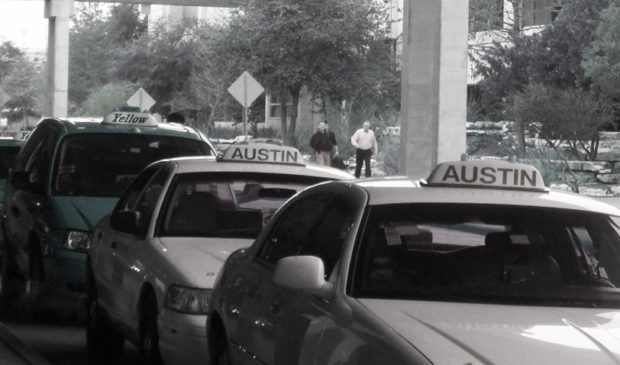Could Austin’s airport taxis break free from the garage?
Wednesday, March 16, 2022 by
Elizabeth Pagano Facing steep declines in ridership, Austin’s taxi industry was offered a glimmer of hope at the most recent City Council meeting.
Earlier this month, Council unanimously approved a change that will have the city license taxis as an operating authority, ending the taxi franchise system that has been in place since 1950. Mayor Steve Adler was absent for the vote.
As part of the resolution – which was ostensibly aimed at bolstering the flagging industry – Council asked the city manager to return by May 1 with recommendations for moving the airport taxi station to a more convenient location. Currently, both cabs and ride-shares are stationed past arrival pickup, on the far side of an airport parking garage.
“I can tell you, as a user of the airport and as somebody who has heard this concern from others as well, there have been times where on my return I’ve actually asked somebody to come pick me up and add a car to that long line of traffic because it is so challenging to get from the airport to the taxi stand,” said Council Member Kathie Tovo, who made the amendment to study how the airport constrains taxi pickups.
In short, Tovo said that the current location of the taxi stand could be creating a disincentive for people to use taxis and adding to the problems of a beleaguered industry.
“It is an on-demand service. I have to believe that there are people that arrive at the airport and don’t see a cab waiting and have to make another arrangement,” Tovo said. “I do think it should be treated differently.”
Her concerns were backed up by Angelo Atem, with ATX Co-op Taxi. In a letter to Council, he explained that an estimated 30 percent of his airport business is gone “because the Airport Authority has hidden us under a garage far away from the view of our customers.”
“We need to go back to where we were,” he wrote.
Austin airport chief Jacqueline Yaft explained that, due to a combination of traffic congestion, limited curb space and a steadily climbing population of passengers, the city opted to move taxis and ride-shares in 2018.
“The traffic at the time was backed up all the way to (Highway) 71,” she said. Since the move, she noted, traffic at the terminal has been “manageable,” despite a recent return to pre-pandemic numbers of travelers, with an estimated 25,000 passengers arriving daily. This year, 20 million passengers are expected to travel through the Austin-Bergstrom International Airport, nearly double what the terminal and curbside were designed to accommodate.
In addition, Yaft said, the airport is on the verge of overhauling its baggage system, and that construction will occupy space at the airport’s arrivals area in the near future. “(W)e don’t really have a lot of curbside to be able to accommodate the number of passengers we are seeing,” she said.
Yaft also worried it could be inequitable to geographically prioritize one type of ground transportation over the others, given that all pay fees to operate at the airport, and that ride-shares – or “transportation network companies” – pay a higher fee.
However, as Mayor Pro Tem Alison Alter noted, taxicab drivers are asked to provide more services to the community than ride-share operators.
Taxis are permitted by the city, which requires 6 percent of the vehicles to be ADA compatible. In addition, federal law does not allow taxicab companies to refuse service to people who use wheelchairs or have other disabilities. TNCs are permitted by the state, and while they may offer options for disabled riders, they are not required to.
Council Member Chito Vela added that walking longer distances could also prove difficult for elderly passengers. “Not to generalize, but I think a lot of elderly folks still rely on cabs and it’s hard for them to get there.”
The airport does operate a tram service on the lower level of the parking garage. Yaft explained that the airport also allows special requests for taxi and other pickups at arrivals for those who need it, and gets about six or seven such requests a day.
Photo made available through a Creative Commons license.
The Austin Monitor’s work is made possible by donations from the community. Though our reporting covers donors from time to time, we are careful to keep business and editorial efforts separate while maintaining transparency. A complete list of donors is available here, and our code of ethics is explained here.
You're a community leader
And we’re honored you look to us for serious, in-depth news. You know a strong community needs local and dedicated watchdog reporting. We’re here for you and that won’t change. Now will you take the powerful next step and support our nonprofit news organization?











